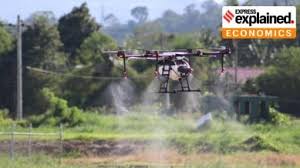Drone Technology in Agriculture

- 02 Sep 2024
In News:
Farmers in Bhagthala Khurd, Kapurthala, and Amritsar are increasingly using drones to apply pesticides to their maize and moong crops. Drones, also known as unmanned aerial vehicles (UAVs), are advanced flying machines that can be operated either autonomously or via remote control.
Drone Technology in Agriculture
While the use of drones in Indian agriculture is still emerging, it shows great potential. In Punjab, 93 out of the 100 drones provided to farmers by the Indian Farmers Fertiliser Cooperative (IFFCO) under the Centre’s ‘NAMO Drone Didi’ scheme are already in operation. Each drone, costing Rs 16 lakh, is equipped with a 12-litre water tank.
Benefits
- Health Protection: Drones minimize farmers' direct exposure to harmful pesticides, reducing the risk of health issues like cancer and kidney problems.
- Efficiency: Drones can spray an acre in just 5-7 minutes, significantly faster than the several hours required for manual application. They ensure a uniform application, which can enhance crop yields.
- Data Collection: Drone data helps pinpoint areas requiring attention, leading to better crop management and increased profits.
- Nano Fertilisers: Drones effectively handle nano fertilisers, ensuring even distribution of these small quantities that are difficult to spread manually.
- Pest Control: Drones enable timely application of pesticides during infestations of pests such as pink bollworms, locusts, and whiteflies.
- Environmental Benefits: Drones improve nutrient absorption from nano fertilisers by up to 90%, reducing runoff and pollution. Leaf-based application is also less polluting than soil-based methods.
- Water Conservation: Drones reduce water usage by up to 90% compared to traditional methods.
- Cost Reduction: They decrease the need for manual labor and reduce pesticide and chemical use, lowering overall costs.
- Additional Uses: Drones are also used to drop seed balls (a mix of soil and cow dung with seeds) for potential reforestation projects.
Challenges
- Job Loss: The use of drones may reduce demand for manual labor, affecting job opportunities for laborers.
- Knowledge and Training: Farmers may lack the necessary skills and training to operate drones effectively.
- Cost: The high cost of drones can be a significant barrier for many farmers.
- Regulatory Barriers: Regulatory challenges may complicate the adoption of drones in agriculture.
Initiatives
- Digital India Campaign: Aims to enhance digital infrastructure and provide training.
- Indian Council of Agricultural Research (ICAR): Promotes precision agriculture technologies, including drones.
- Production Linked Incentive (PLI) Scheme: Offers Rs. 120 crore (US$ 14.39 million) to incentivize domestic drone manufacturing and reduce import reliance.
- Sub-Mission on Agricultural Mechanization (SMAM): Provides financial aid to farmers purchasing drones, making technology more accessible.
- NAMO Drone Didi Scheme: Launched to empower women Self-Help Groups (SHGs) and provide access to modern agricultural technology.
- Support and Training: Efforts are underway to offer training and support to farmers to overcome adoption barriers.
Conclusion and Way Forward
Drone technology holds the promise of transforming agriculture by boosting efficiency, yields, and cost-effectiveness. In Punjab, where traditional manual methods have prevailed, drones offer a new approach to pesticide and fertiliser application. It is essential for farmers and policymakers to work together to address challenges and ensure that the benefits of drones are fully realized while mitigating any potential drawbacks.
